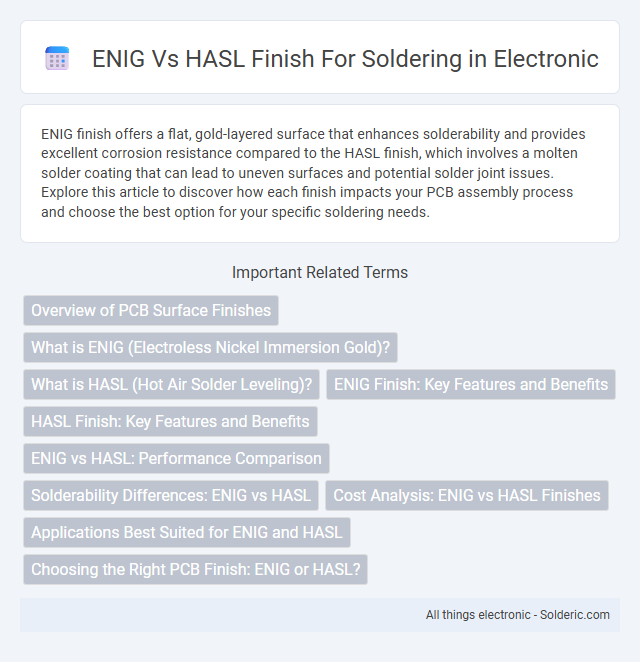ENIG finish offers a flat, gold-layered surface that enhances solderability and provides excellent corrosion resistance compared to the HASL finish, which involves a molten solder coating that can lead to uneven surfaces and potential solder joint issues. Explore this article to discover how each finish impacts your PCB assembly process and choose the best option for your specific soldering needs.
Comparison Table
| Feature | ENIG (Electroless Nickel Immersion Gold) | HASL (Hot Air Solder Leveling) |
|---|---|---|
| Surface Composition | Nickel layer with a thin gold coating | Tinned copper with solder coating |
| Solderability | Excellent, reliable for fine-pitch components | Good, but less consistent on fine-pitch pads |
| Flatness | Highly flat surface, ideal for BGA and fine-pitch components | Less flat due to solder wave, not ideal for fine-pitch parts |
| Thermal Resistance | Good, withstands multiple reflow cycles | Moderate, may degrade with repeated heat exposure |
| Cost | Higher due to precious metal use | Lower, economically favorable for mass production |
| Environmental Impact | RoHS compliant, less hazardous materials | Contains lead in some variants, less eco-friendly |
| Corrosion Resistance | Excellent, long shelf life | Moderate, can oxidize over time |
| Application | High-reliability electronics, aerospace, medical | General electronics, consumer products |
Overview of PCB Surface Finishes
ENIG (Electroless Nickel Immersion Gold) provides a flat, solderable surface ideal for fine-pitch components and offers excellent oxidation resistance, ensuring reliable long-term performance in PCB assembly. HASL (Hot Air Solder Leveling) is a cost-effective finish where molten solder covers the PCB pads, providing good solderability but potentially uneven surfaces that may affect fine-pitch soldering. Your choice between ENIG and HASL depends on the specific requirements for surface planarity, durability, and cost in your PCB manufacturing process.
What is ENIG (Electroless Nickel Immersion Gold)?
ENIG (Electroless Nickel Immersion Gold) is a surface finish used in printed circuit boards (PCBs) where a layer of nickel is chemically deposited onto the copper pads, followed by a thin layer of immersion gold to protect the nickel from oxidation. This finish provides excellent flatness, superior solderability, and enhanced corrosion resistance compared to HASL (Hot Air Solder Leveling), making it ideal for fine-pitch components and advanced electronic assemblies. ENIG's nickel layer also acts as a diffusion barrier, preventing copper migration and ensuring reliable electrical performance over time.
What is HASL (Hot Air Solder Leveling)?
HASL (Hot Air Solder Leveling) is a surface finish process where printed circuit boards are dipped into molten solder and then passed through hot air knives to remove excess solder, ensuring a uniform coating. This finish provides excellent solderability and is widely used due to its cost-effectiveness and reliability in creating strong solder joints. For your PCB assembly, choosing HASL affects the board's flatness and suitability for fine-pitch components compared to ENIG finishes.
ENIG Finish: Key Features and Benefits
ENIG (Electroless Nickel Immersion Gold) finish offers exceptional flatness and superior solderability, making it ideal for fine-pitch and high-density PCB assemblies. Its corrosion resistance and oxidation protection ensure reliable long-term electrical performance, especially in harsh environments. You benefit from consistent wetting and stronger solder joints, enhancing overall manufacturing yield and product durability.
HASL Finish: Key Features and Benefits
HASL finish offers excellent solderability due to its smooth, solder-coated surface, ensuring reliable wetting during the soldering process. It provides effective protection against oxidation and is cost-effective, making it a popular choice for a wide range of PCB applications. Your assemblies benefit from consistent thickness and durability, enhancing long-term performance in various electronic environments.
ENIG vs HASL: Performance Comparison
ENIG (Electroless Nickel Immersion Gold) offers superior surface flatness and excellent oxidation resistance compared to HASL (Hot Air Solder Leveling), resulting in more consistent solder joints and improved long-term reliability. HASL provides a cost-effective coating with good solderability but may introduce uneven surfaces that affect fine-pitch components and delicate soldering processes. Your choice between ENIG and HASL depends on performance requirements such as durability, thermal cycling, and precision in soldering applications.
Solderability Differences: ENIG vs HASL
ENIG (Electroless Nickel Immersion Gold) finish offers superior and more consistent solderability compared to HASL (Hot Air Solder Leveling) due to its flat and uniform surface, which enhances solder wetting and joint reliability. HASL, with its uneven and thicker solder coating, can cause solderability issues such as tombstoning and insufficient wetting, especially on fine-pitch components and fine traces. The gold layer in ENIG prevents oxidation and ensures longer shelf life, improving solder joint quality and minimizing defects in high-density PCB assemblies.
Cost Analysis: ENIG vs HASL Finishes
ENIG (Electroless Nickel Immersion Gold) finish typically incurs higher costs than HASL (Hot Air Solder Leveling) due to its complex plating process and premium materials. HASL offers a more cost-effective solution with lower upfront expenses, making it suitable for high-volume or budget-sensitive PCB production. The enhanced durability and superior solderability of ENIG justify its premium price in applications demanding long-term reliability and fine-pitch components.
Applications Best Suited for ENIG and HASL
ENIG (Electroless Nickel Immersion Gold) finish is best suited for high-density, fine-pitch PCB applications such as aerospace, medical devices, and advanced electronics due to its flat surface and excellent corrosion resistance. HASL (Hot Air Solder Leveling) is ideal for cost-sensitive, through-hole components and general-purpose boards where surface flatness is less critical. Understanding your PCB's complexity and end-use environment will help you choose the appropriate finish for optimal soldering performance.
Choosing the Right PCB Finish: ENIG or HASL?
ENIG (Electroless Nickel Immersion Gold) provides a flat, reliable surface ideal for fine-pitch components and multiple soldering cycles, while HASL (Hot Air Solder Leveling) is cost-effective with good solderability but may cause uneven surfaces unsuitable for high-density boards. Your choice between ENIG or HASL depends on factors like PCB complexity, thermal performance, and production budget. Selecting the right finish ensures stronger solder joints and enhances overall circuit reliability.
ENIG vs HASL finish for soldering Infographic

 solderic.com
solderic.com